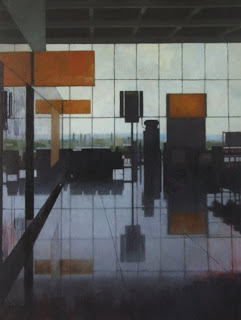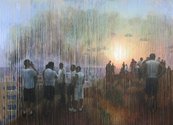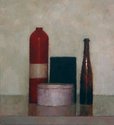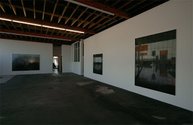John Hurrell – 19 March, 2009
The sense of drama achieved by using a historical narrative is a new area for Rae, one that moves away from her usual contemplative spatial preoccupations towards active commentary. A shift from quietistic murmurings to that of being more actively vocal. An interest in the social manifest in paint.
Sydney
Jude Rae
10 March - 17 April 2009
Jude Rae is well known for her various painting projects over the years since she began in the early nineties, from dramatically twisted sheets and superimposed texts, to innovative industrial still lifes using gas cylinders and fire extinguishers, and ambiguous crumpled sheets that suggestively teased between what they might be covering and what may have laid on top of them.
In recent years she has become much more interested in architectural space, and even her small Morandi influenced still lifes have reflected that. She once worked in black, white and chromatically nuanced greys but now even her still lifes have an Impressionist feel. The object surfaces and forms are very solid, but the chromatic flicks on their ‘skins’ pulse and shimmer. The light is on surfaces, and not say in the air. There is no atmospheric dematerialization. Closer to Chardin in essence than Monet.
There are five works in the big downstairs Jensen gallery. One is a receding dark corridor inside a Parisian block of flats with light glowing from a window on a distant landing. The blue black shadows are dramatic and propel you to rush forward. Two other works are based on T5 at Heathrow and tease out spatial contradictions apparent upon and behind a dominant glass window, and before it, receding and reflective tiled floors. The rusty horizontal rectangles and umber vertical beams seem to float, serving as foils to the thin diagonal floor lines.
The smaller of the T5 works features distant silhouetted people against the window-gridded sunlight. Its ‘human’ content links it to the key work in the exhibition, a painting based on a newspaper photograph of a group of bystanders in Lebanon watching the Israeli bombing of Beirut in 2006.
The work has an ambiguous image of billowing smoke and a distant flash on the distant horizon - a parallel of images of the testing of the very first Atomic bomb - and the rectangular surface is covered with delicate trickles of thin blue and orange paint that discretely optically activate it. The sense of drama achieved by using a historical narrative is a new area for Rae, one that moves away from her usual contemplative spatial preoccupations towards active commentary. A shift from quietistic murmurings to that of being more actively vocal. An interest in the social manifest in paint.
- Emma Jameson





 Two Rooms presents a program of residencies and projects
Two Rooms presents a program of residencies and projects Advertising in this column
Advertising in this column



This Discussion has 0 comments.
Comment
Participate
Register to Participate.
Sign in
Sign in to an existing account.